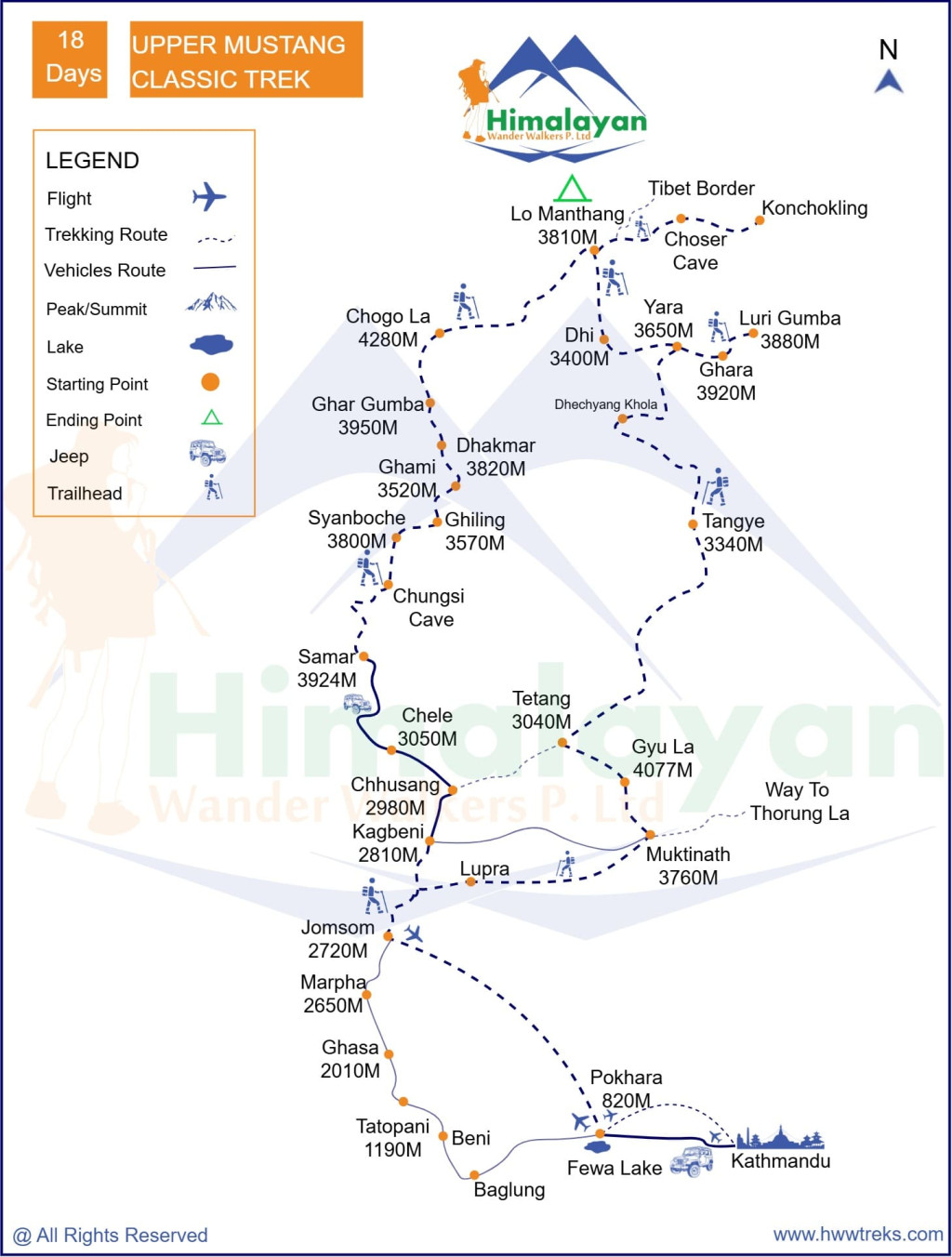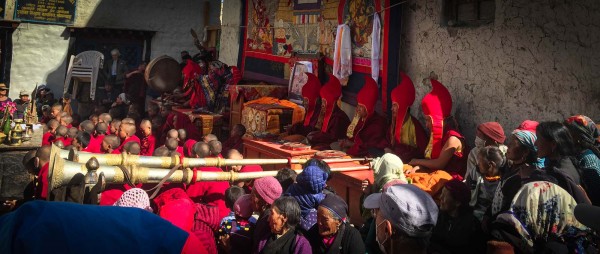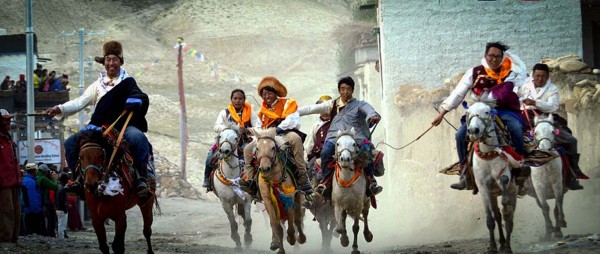Important Information
Region
Mustang Region Treks
Duration
18 Days
Max Altitude 4200 Meters
Best Season Spring, Summer & Autumn
Activity Per Day
4-5 Hours Walk
Grade
Level 3
Group Size
2 - 12 people
Transportation Bus/Flight/Jeep
Explore the hidden kingdom of Upper Mustang beyond the great Himalayas, featuring the 12th century pure Tibetan culture and religion with astounding landscapes.
Upper Mustang, the place which reflects the pure Tibetan culture and tradition since 12th century, located at the northern Kora La, border to China, having the lowest elevation of 2,750m on the Kali Gandaki River just north of Kagbeni and the highest point of 6,700 m at Khamjung Himal, a peak in southeast Mustang. The kingdom has its own history since the 13th century and the king had successfully ruled the kingdom till 2008 AD with 25th descendent. It is the small kingdom beyond the great Himalayas and known from different names like high altitude desert, rain shaded area, and the forbidden kingdom of Lo.
Tourist from all over the world comes to visit Upper Mustang for the cultural attraction and the spectacular landscape. The place is blessed with a large number of centuries back Tibetan Buddhist Monasteries, Chorten (Stupa), and numerous pilgrimage sites. Lo-Gekar monastery (Ghar Gonpa) in Upper mustang is considered as the first monastery of Tibet built by a great Tantric Master of 8th century Guru Padma Sambava who contributed his whole life flourishing Buddhism in Tibet. Another fascinating site is the ancient walled city of Lo-Manthang where the people still reside in the walled city portraying the live tradition and culture of the century back livelihood.
Following the trekking route to Upper Mustang will unveil the enchanting view of Canyon, ridge, ancient caves, colorful Chorten, Monasteries, Mani walls, and cliffs which manifests the unique landscape and the culture of the localities. The trekking season is from late March to early November. Normally, most visitors make targets for May month to visit the Tiji festival (a ritual dance performed by the Monk) and August for the Yartong festivals (Horse riding ceremonies).
If you are looking for a different itinerary than the one here, please Customize Your Trip.
Highlights of the Upper Mustang Trek
- Hidden kingdom of Lo beyond the great Himalayas
- The ultimate place to visit the pure Tibetan culture and traditions
- Spectacular landscape formation
- The ancient walled city of Lo-Manthang
- Century back Monasteries and Buddhist monuments
"Best decision ever if you want to visit Nepal
When it came to my mind that I need to go to Nepal for seeing the holy sites of that beautiful country, I thought about traveling on my own. Thank god I didn't! I met that amazing group of talented organizers that made my time in Nepal just amazingly beautiful. Visiting the beautiful sites in Kathmandu I was accompanied by Rigzin who has amazing knowledge about culture, architecture, history, people, traditions, spiritual stories, and rites. No question remained unanswered. On my way further into the mountains of Mustang, I was accompanied by Dorjee. What a kind, open-minded and caring companion. He did not organize everything necessary on the way but took care of every step I made by preserving my very own space and rhythm. I enjoyed every single second in his presence. Last but not least I want to thank all of you for organizing my stay and also my rebookings due to the corona crisis. I went home safe and really happy having been traveling with you. I recommend you to everyone who wants to visit Nepal regardless of whatever organized or individualized travels you want to do in Nepal. I will be back for sure and finish my beautiful trip whenever its time for it. Take care and stay safe. Thank you from deep within my heart." By Katja, Germany. Read our more reviews here: Clients Review
Include
Airport pick up and drop off
Domestic flight from Pokhara to Jomsom and back to Pokhara
English-speaking government license holder trekking guide
One porter for two persons
Trekking guide’s and porter’s insurance during the trip
TIMS trekking permit
Annapurna conservation permit
Upper Mustang Special permit
Bus fare from Kathmandu to Pokhara and back to Kathmandu
Hotel in Kathmandu, Pokhara, and Jomsom
Accommodation during the trek
All Government and local taxes.
Arrangement of emergency evacuation service (should have insurance for emergency evacuation and will be paid by your travel insurance company)
Meal (breakfast, lunch, and dinner) during the trek
Sightseeing and entrance fee
Exclude
All the drinks except teas
Personal trekking equipment
A meal in Pokhara and Kathmandu
Emergency rescue evacuation
Phone calls
Internet
Travel/medical insurance
horse riding
monastery entry fee
International air ticket
Tips for your trekking guide & porters at the end of the trek
Anything not mentioned in the ‘includes section’
Route Map

Important Information
CHECKLISTS FOR UPPER MUSTANG CLASSIC TREK
- Valid passport (valid for six months from the date of your trip)
- MasterCard, Visa Credit, and Debit Cards are accepted in Nepal. However, some cash is highly recommended.
- Mobile (if your cell phone is from CINGULAR USA or ATNT (USA) operators, then your cell phone will work in Nepal.)
- Clothing (Layered clothes, windproof and waterproof jackets, fleece pullovers, thermal base layers, hiking pants, shorts, headwear, footwear, and other items according to your needs)
- Personal Items and Toiletries (First-Aid Kit, Iodine tablets or a UV purifier to treat water, Sun Protection)
- Travel and Health Insurance
- Trekking gear and equipment(if you have your own trekking gear and equipment, such as trekking poles, sleeping bag, and shoes, then you can bring them; else you can rent them in Thamel, Kathmandu). Read more for trekking gears and peak climbing gears.
Guiding, Food, and Lodging
In Nepal, all trekking supplies - Teahouse trekking means staying and eating in local lodges. We stay in single rooms where possible, but often you will have to share. The rooms are basic, normally just a bed with a pillow, blankets. A few have electric lights and all have a spacious dining room-lounge. We eat at teahouses and, although the food is usually plentiful and delicious, the menu is not expensive. They offer a variety of potatoes, rice and noodle dishes, as well as soup and seasonal vegetables. Beers and local spirits are often available, but that will be at your own cost. A variety of cereals, bread, and egg dishes are generally available for breakfast. There are also snacks available such as basic biscuits, chocolate, and soft drinks and in some areas, you will find fresh fruit in season. It is normal to meet your porter in the teahouse where you will stay overnight. So, pack your necessary things in your own day pack.
DRESS CODE FOR VISITING MONASTERIES, AND TEMPLES IN NEPAL
- Shirt (either half or full sleeve)
- Full pants/long skirts
- Any type of shoes with socks
- No Hats, No Umbrella, No Slippers, No t-shirts, No short skirt, and No half-pants
- Photographs allowed in the courtyard only.
Note regarding itineraries
Although we generally adhere to the schedule, the itinerary is subject to change for numerous reasons beyond our control, including weather and terrain conditions, suitable campsite availability, and the group's general fitness level. It is important to understand that our trek is logistically complex and it is not unusual that adjustments be made. Our guide will orient you each evening to the following day's plan; their good judgment is the key to the long history of successful treks that Himalayan Wander Walkers has led till now. Please remember that our ability to make adjustments as needed helps to ensure that your trek is successful.
Frequently Asked Question
Yes, the Upper Mustang Class Trek can be customized to meet your needs. We can modify the itinerary based on your preferences, whether you want to shorten or extend the trek or add extra rest days. If you're interested in specific destinations, such as monasteries or villages, we can adjust the route to include those as well. Just let us know what you're looking for, and we’ll be happy to accommodate your wishes: “Customize Your Trip.”
For the Upper Mustang Classic Trek, you need a Restricted Area Permit and an ACAP (Annapurna Conservation Area Permit), which can be easily obtained from a government-licensed company in Kathmandu or Pokhara. These permits are required to ensure safety and preserve the region’s unique culture and environment. Read more about trekking permits and their cost in the Mustang Region.
Altitude sickness can occur in regions above 2,500 meters, and the Upper Mustang Classic Trek takes you to elevations over 4,200 meters, so you might face some symptoms of altitude sickness, and acclimatization is important. This tour is designed with rest days to help you adjust. Staying hydrated, avoiding exertion, and listening to your body are essential. If symptoms of altitude sickness occur, your guide will assist in descending to a lower altitude for recovery.
For the Upper Mustang Classic Trek, you need to have sturdy trekking boots, trekking sticks (if you need them), a proper and strong wind cheater, all your medication, along with a water purification pill, sleeping bags, energy bars, hats to block the sun, and proper SPF sunscreen. Read more about trekking gear.
Yes, you will have enough internet access in the Upper Mustang Region. Both Wi-Fi and cellphone Internet are widely available in all overnight stop places. Read more about Internet service in Upper Mustang.
Yes, we (Himalayan Wander Walkers) will supply you with an experienced and informed local guide. They will lead you as they are familiar with every location in this area. They can also serve as a mediator between you and other individuals because they speak English fluently. They will also provide you with the information you need regarding the history, culture, religion, and customs of the area. Since they have had basic first aid training, they will respond to any accidents or incidents right away.
No questions found matching your search. Try different keywords or browse all questions above.
| {{type.min}} - {{type.max}} Pax {{type.name}} - {{type.desc}} | {{type.display_price}} per people |
Extra prices:
Let us help you decide Inquiry
You might also like

- 17 days
- Mustang Region Treks
Tiji Festival in Upper Mustang
Are you looking for local travel agency to organize your Tiji Festival Trek to Upper Mustang in the year 2026 and 2027? The date for Tiji Festival Trek 2026 and 2027 is already updated. The Tiji festival Trek year 2026 will be celebrating on the 13th, 14th and 15th May 2026. According to the...



